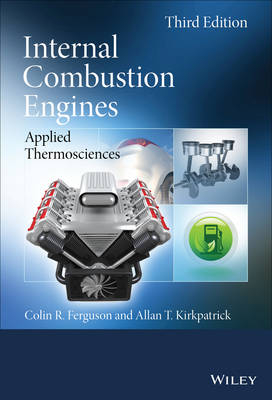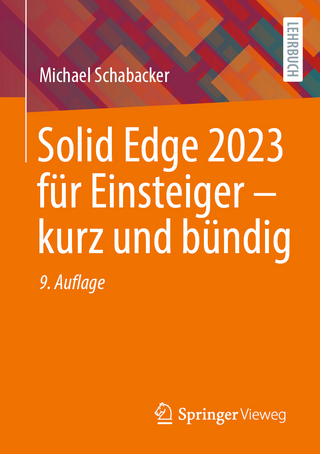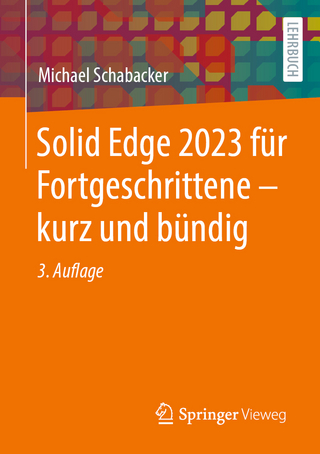
Internal Combustion Engines
John Wiley & Sons Inc (Verlag)
978-1-118-53331-4 (ISBN)
- Titel erscheint in neuer Auflage
- Artikel merken
Colin R. Ferguson was the author of the first edition of Internal Combustion Engines in 1986, and was listed on the 2001 second edition for continuity. He did not participate in the second edition, and for continuity was listed in the second edition as an affiliate faculty member in Mechanical Engineering at Colorado State University. He is listed in this third edition again for continuity. Allan T Kirkpatrick is Professor of Mechanical Engineering at Colorado State University, USA.? He obtained his Ph. D in Mechanical Engineering in 1981 from Massachusetts Institute of Technology, and his current society memberships include American Society of Mechanical Engineers, and Society of Automotive Engineers (SAE). He is the author of numerous journals articles and conference proceedings, and is the co-author of Internal Combustion Engines, Second Edition (Wiley).
Preface xi Acknowledgments xiii 1. Introduction to Internal Combustion Engines 1 1.1 Introduction 1 1.2 Historical Background 4 1.3 Engine Cycles 5 1.4 Engine Performance Parameters 9 1.5 Engine Configurations 16 1.6 Examples of Internal Combustion Engines 23 1.7 Alternative Power Plants 26 1.8 References 29 1.9 Homework 30 2. Heat Engine Cycles 32 2.1 Introduction 32 2.2 Constant Volume Heat Addition 33 2.3 Constant Pressure Heat Addition 36 2.4 Limited Pressure Cycle 37 2.5 Miller Cycle 39 2.6 Finite Energy Release 41 2.7 Ideal Four-Stroke Process and Residual Fraction 54 2.8 Discussion of Gas Cycle Models 62 2.9 References 63 2.10 Homework 64 3. Fuel, Air, and Combustion Thermodynamics 66 3.1 Introduction 66 3.2 Thermodynamic Properties of Ideal Gas Mixtures 66 3.3 Liquid--Vapor--Gas Mixtures 72 3.4 Stoichiometry 76 3.5 Low-Temperature Combustion Modeling 79 3.6 General Chemical Equilibrium 84 3.7 Chemical Equilibrium using Equilibrium Constants 89 3.8 References 94 3.9 Homework 94 4. Fuel--Air Combustion Processes 97 4.1 Introduction 97 4.2 Combustion and the First Law 97 4.3 Maximum Work and the Second Law 103 4.4 Fuel--Air Otto Cycle 108 4.5 Four-Stroke Fuel--Air Otto Cycle 113 4.6 Homogeneous Two-Zone Finite Heat Release Cycle 116 4.7 Comparison of Fuel--Air Cycles with Actual Spark Ignition Cycles 123 4.8 Limited Pressure Fuel--Air Cycle 125 4.9 Comparison of Limited Pressure Fuel--Air Cycles with Actual Compression Ignition Cycles 128 4.10 References 129 4.11 Homework 129 5. Intake and Exhaust Flow 131 5.1 Introduction 131 5.2 Valve Flow 131 5.3 Intake and Exhaust Flow 147 5.4 Superchargers and Turbochargers 150 5.5 Effect of Ambient Conditions on Engine and Compressor Mass Flow 158 5.6 References 159 5.7 Homework 160 6. Fuel and Airflow in the Cylinder 163 6.1 Introduction 163 6.2 Carburetion 163 6.3 Fuel Injection--Spark Ignition 166 6.4 Fuel Injection--Compression Ignition 168 6.5 Large-Scale in-Cylinder Flow 174 6.6 In-Cylinder Turbulence 180 6.7 Airflow in Two-Stroke Engines 185 6.8 References 193 6.9 Homework 195 7. Combustion Processes in Engines 197 7.1 Introduction 197 7.2 Combustion in Spark Ignition Engines 198 7.3 Abnormal Combustion (Knock) in Spark Ignition Engines 206 7.4 Combustion in Compression Ignition Engines 214 7.5 Low-Temperature Combustion 225 7.6 References 229 7.7 Homework 231 8. Emissions 234 8.1 Introduction 234 8.2 Nitrogen Oxides 235 8.3 Carbon Monoxide 243 8.4 Hydrocarbons 245 8.5 Particulates 249 8.6 Emissions Regulation and Control 251 8.7 References 258 8.8 Homework 259 9. Fuels 262 9.1 Introduction 262 9.2 Hydrocarbon Chemistry 263 9.3 Refining 266 9.4 Fuel Properties 267 9.5 Gasoline Fuels 269 9.6 Alternative Fuels for Spark Ignition Engines 274 9.7 Hydrogen 281 9.8 Diesel Fuels 282 9.9 References 286 9.10 Homework 287 10. Friction and Lubrication 288 10.1 Introduction 288 10.2 Friction Coefficient 288 10.3 Friction Mean Effective Pressure 291 10.4 Friction Measurements 291 10.5 Friction Modeling 294 10.6 Journal Bearing Friction 295 10.7 Piston and Ring Friction 298 10.8 Valve Train Friction 306 10.9 Accessory Friction 308 10.10 Pumping Mean Effective Pressure 310 10.11 Overall Engine Friction Mean Effective Pressure 311 10.12 Lubrication 312 10.13 References 315 10.14 Homework 316 11. Heat and Mass Transfer 318 11.1 Introduction 318 11.2 Engine Cooling Systems 319 11.3 Engine Energy Balance 320 11.4 Cylinder Heat Transfer 324 11.5 Heat Transfer Modeling 326 11.6 Heat Transfer Correlations 330 11.7 Heat Transfer in the Exhaust System 338 11.8 Radiation Heat Transfer 339 11.9 Mass Loss or Blowby 340 11.10 References 342 11.11 Homework 344 12. Engine Testing and Control 346 12.1 Introduction 346 12.2 Instrumentation 347 12.3 Combustion Analysis 354 12.4 Exhaust Gas Analysis 358 12.5 Control Systems in Engines 366 12.6 Vehicle Emissions Testing 369 12.7 References 370 12.8 Homework 370 13. Overall Engine Performance 372 13.1 Introduction 372 13.2 Effect of Engine and Piston Speed 372 13.3 Effect of Air--Fuel Ratio and Load 373 13.4 Engine Performance Maps 376 13.5 Effect of Engine Size 379 13.6 Effect of Ignition and Injection Timing 380 13.7 Effect of Compression Ratio 383 13.8 Vehicle Performance Simulation 383 13.9 References 384 13.10 Homework 385 Appendices 387 A Physical Properties of Air 387 B Thermodynamic Property Tables for Various Ideal Gases 389 C Curve-Fit Coefficients for Thermodynamic Properties of Various Fuels and Ideal Gases 397 D Conversion Factors and Physical Constants 401 E Thermodynamic Analysis of Mixtures 403 E.1 Thermodynamic Derivatives 403 E.2 Numerical Solution of Equilibrium Combustion Equations 405 E.3 Isentropic Compression/Expansion with Known P 408 E.4 Isentropic Compression/Expansion with Known v 409 E.5 Constant Volume Combustion 410 E.6 Quality of Exhaust Products 411 E.7 References 412 F Computer Programs 413 F.1 Volume.m 414 F.2 Velocity.m 414 F.3 BurnFraction.m 414 F.4 FiniteHeatRelease.m 415 F.5 FiniteHeatMassLoss.m 417 F.6 FourStrokeOtto.m 420 F.7 RunFarg.m 421 F.8 farg.m 422 F.9 fuel.m 425 F.10 RunEcp.m 426 F.11 ecp.m 427 F.12 AdiabaticFlameTemp.m 437 F.13 OttoFuel.m 438 F.14 FourStrokeFuelAir.m 440 F.15 Homogeneous.m 444 F.16 Friction.m 450 F.17 WoschniHeatTransfer.m 451 Index 455
| Verlagsort | New York |
|---|---|
| Sprache | englisch |
| Maße | 181 x 260 mm |
| Gewicht | 1090 g |
| Themenwelt | Technik ► Maschinenbau |
| ISBN-10 | 1-118-53331-3 / 1118533313 |
| ISBN-13 | 978-1-118-53331-4 / 9781118533314 |
| Zustand | Neuware |
| Informationen gemäß Produktsicherheitsverordnung (GPSR) | |
| Haben Sie eine Frage zum Produkt? |
aus dem Bereich



